Comprehensive Study: Building Law and Security of Payment Act 1999
VerifiedAdded on 2022/10/11
|9
|2703
|17
Essay
AI Summary
This essay provides a comprehensive analysis of the Building and Construction Industry Security of Payment Act 1999. It begins with an introduction to the Act, established in Australia in 1999, and its purpose of securing payments in the construction industry. The essay then elaborates on the working principles of the Act, including the application process, first and second notices, and adjudication. It explores the reasons for the Act's introduction, highlighting issues related to payment discrimination and the need for a legislative scheme. The essay further examines the Act's relationship with regular court actions, detailing how it facilitates payment recovery through adjudication and court judgments. Finally, it discusses recent amendments to the Act, such as the removal of payment claim declarations, the provision of supporting statements, and fixed deadlines for progress payments, including the rights of subcontractors. The essay concludes by summarizing the Act's significance in protecting the rights of suppliers and contractors within the construction industry.
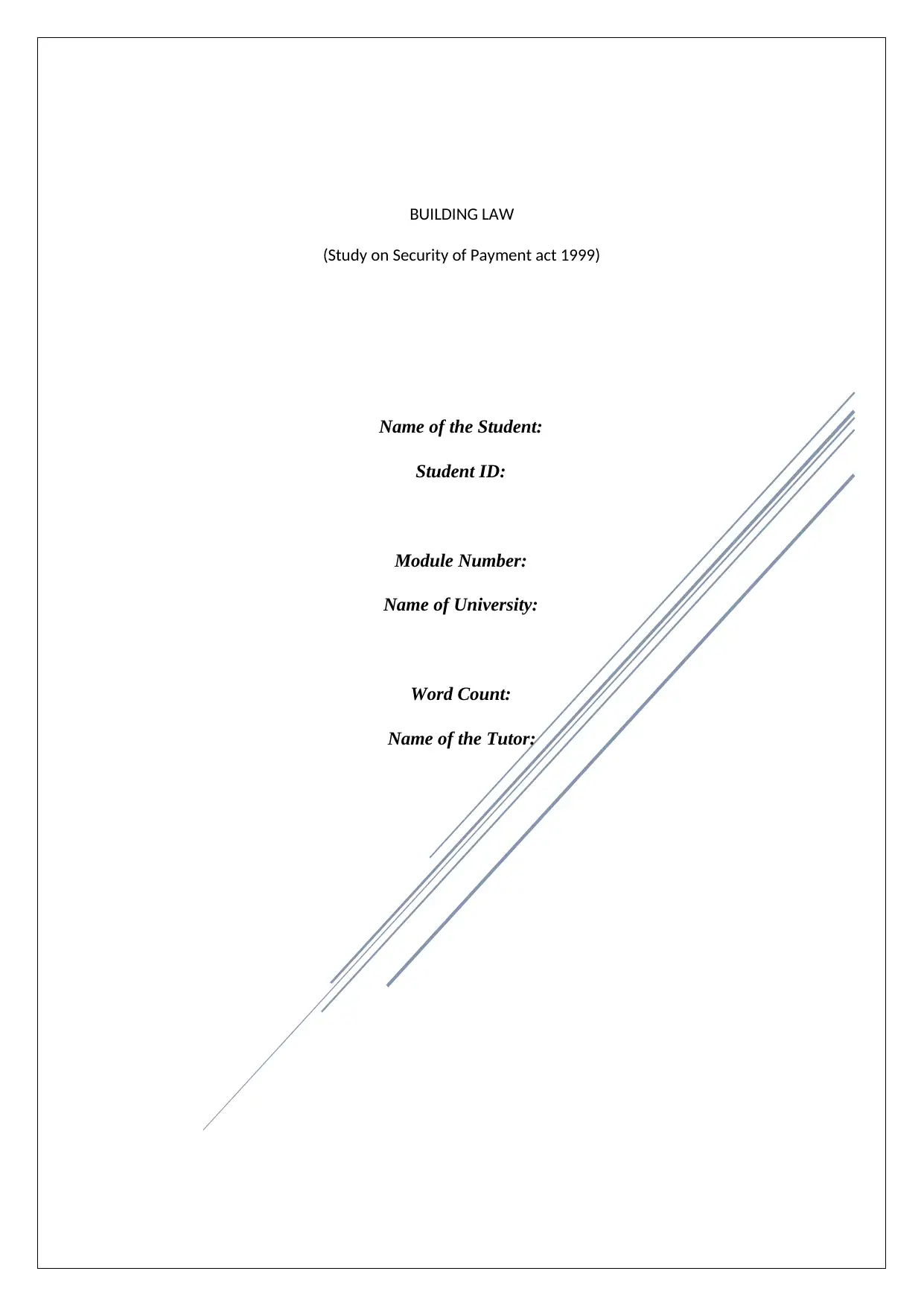
Name of the Student:
Student ID:
Module Number:
Name of University:
Word Count:
Name of the Tutor:
BUILDING LAW
(Study on Security of Payment act 1999)
Student ID:
Module Number:
Name of University:
Word Count:
Name of the Tutor:
BUILDING LAW
(Study on Security of Payment act 1999)
Paraphrase This Document
Need a fresh take? Get an instant paraphrase of this document with our AI Paraphraser
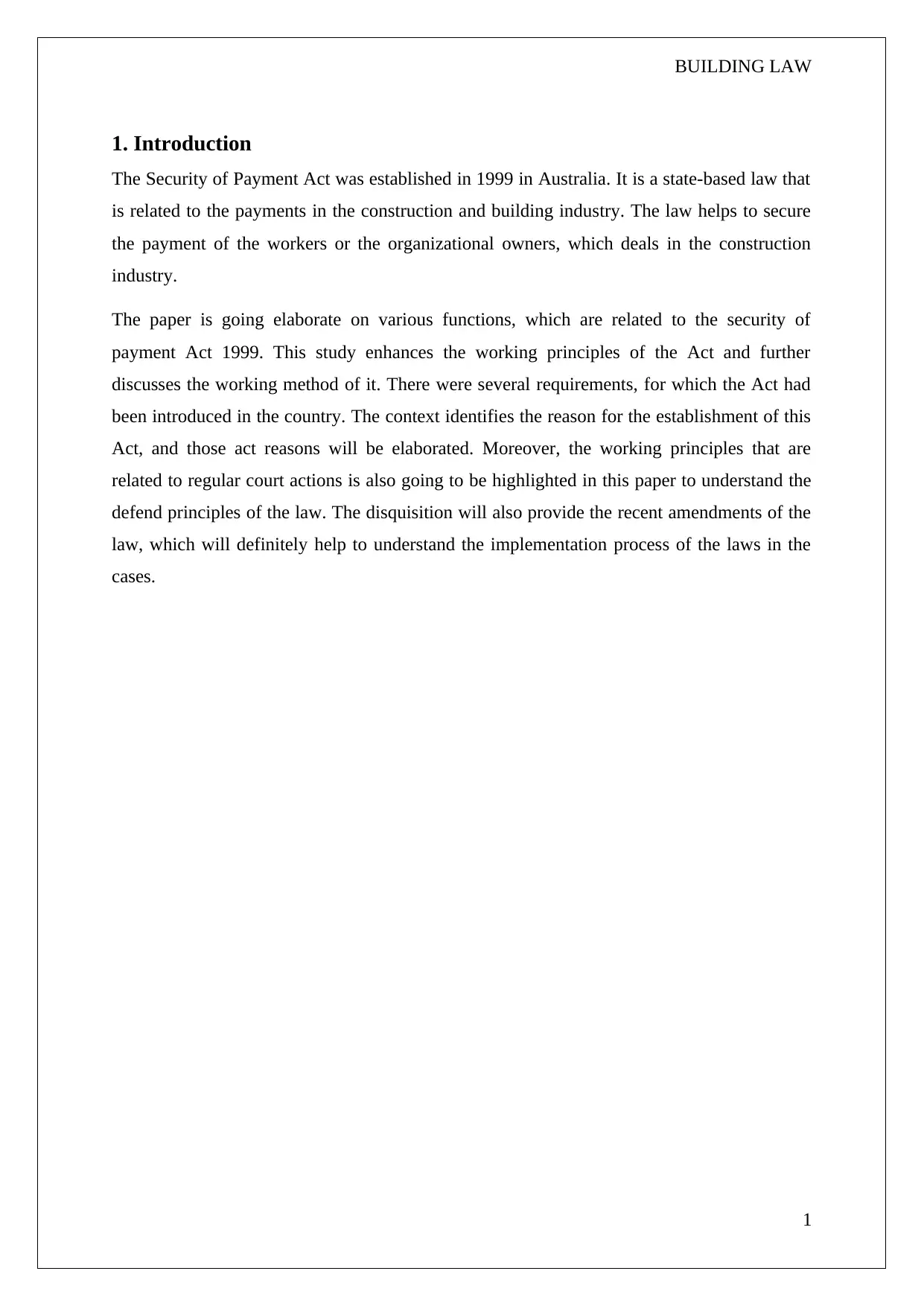
BUILDING LAW
1. Introduction
The Security of Payment Act was established in 1999 in Australia. It is a state-based law that
is related to the payments in the construction and building industry. The law helps to secure
the payment of the workers or the organizational owners, which deals in the construction
industry.
The paper is going elaborate on various functions, which are related to the security of
payment Act 1999. This study enhances the working principles of the Act and further
discusses the working method of it. There were several requirements, for which the Act had
been introduced in the country. The context identifies the reason for the establishment of this
Act, and those act reasons will be elaborated. Moreover, the working principles that are
related to regular court actions is also going to be highlighted in this paper to understand the
defend principles of the law. The disquisition will also provide the recent amendments of the
law, which will definitely help to understand the implementation process of the laws in the
cases.
1
1. Introduction
The Security of Payment Act was established in 1999 in Australia. It is a state-based law that
is related to the payments in the construction and building industry. The law helps to secure
the payment of the workers or the organizational owners, which deals in the construction
industry.
The paper is going elaborate on various functions, which are related to the security of
payment Act 1999. This study enhances the working principles of the Act and further
discusses the working method of it. There were several requirements, for which the Act had
been introduced in the country. The context identifies the reason for the establishment of this
Act, and those act reasons will be elaborated. Moreover, the working principles that are
related to regular court actions is also going to be highlighted in this paper to understand the
defend principles of the law. The disquisition will also provide the recent amendments of the
law, which will definitely help to understand the implementation process of the laws in the
cases.
1
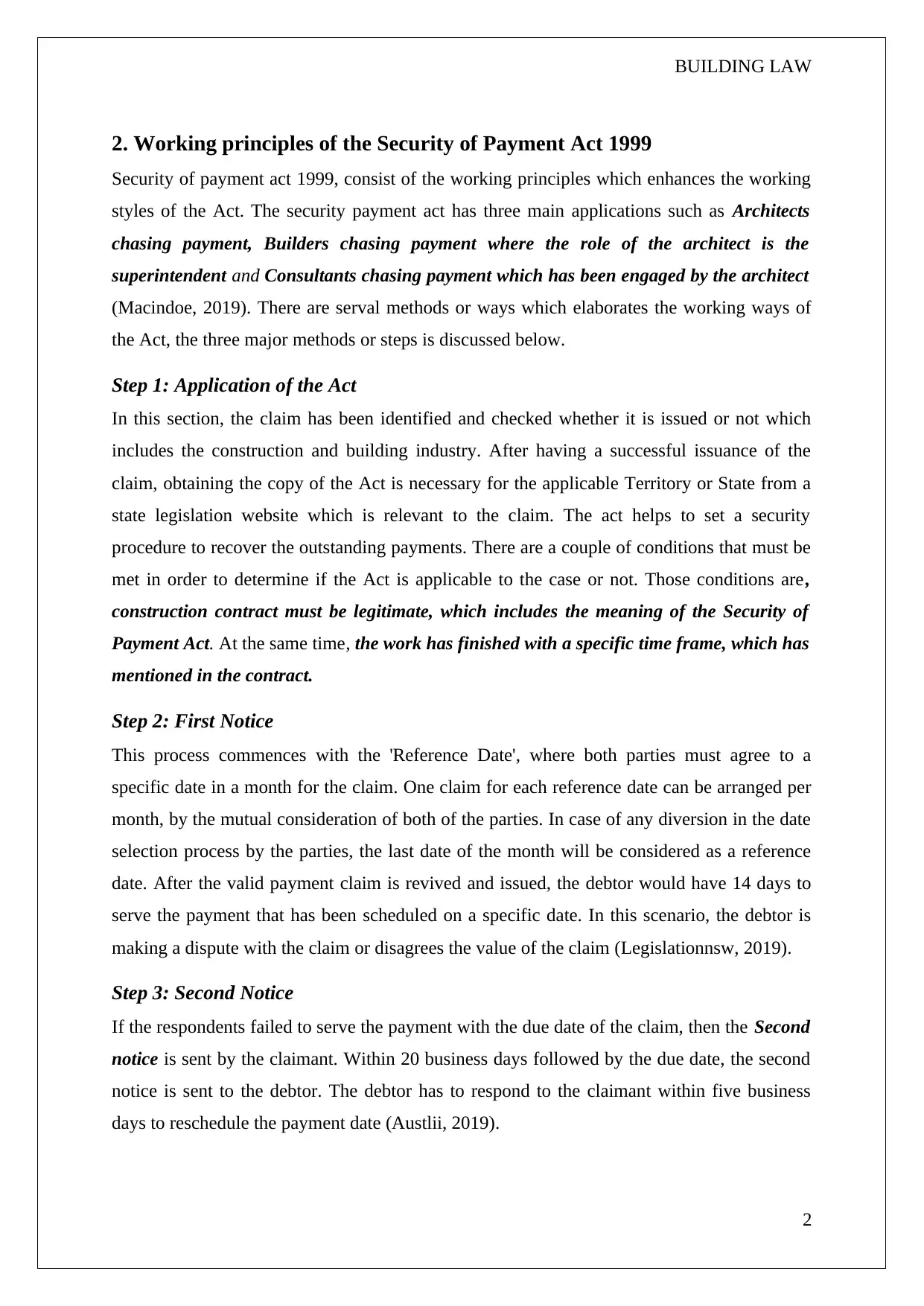
BUILDING LAW
2. Working principles of the Security of Payment Act 1999
Security of payment act 1999, consist of the working principles which enhances the working
styles of the Act. The security payment act has three main applications such as Architects
chasing payment, Builders chasing payment where the role of the architect is the
superintendent and Consultants chasing payment which has been engaged by the architect
(Macindoe, 2019). There are serval methods or ways which elaborates the working ways of
the Act, the three major methods or steps is discussed below.
Step 1: Application of the Act
In this section, the claim has been identified and checked whether it is issued or not which
includes the construction and building industry. After having a successful issuance of the
claim, obtaining the copy of the Act is necessary for the applicable Territory or State from a
state legislation website which is relevant to the claim. The act helps to set a security
procedure to recover the outstanding payments. There are a couple of conditions that must be
met in order to determine if the Act is applicable to the case or not. Those conditions are,
construction contract must be legitimate, which includes the meaning of the Security of
Payment Act. At the same time, the work has finished with a specific time frame, which has
mentioned in the contract.
Step 2: First Notice
This process commences with the 'Reference Date', where both parties must agree to a
specific date in a month for the claim. One claim for each reference date can be arranged per
month, by the mutual consideration of both of the parties. In case of any diversion in the date
selection process by the parties, the last date of the month will be considered as a reference
date. After the valid payment claim is revived and issued, the debtor would have 14 days to
serve the payment that has been scheduled on a specific date. In this scenario, the debtor is
making a dispute with the claim or disagrees the value of the claim (Legislationnsw, 2019).
Step 3: Second Notice
If the respondents failed to serve the payment with the due date of the claim, then the Second
notice is sent by the claimant. Within 20 business days followed by the due date, the second
notice is sent to the debtor. The debtor has to respond to the claimant within five business
days to reschedule the payment date (Austlii, 2019).
2
2. Working principles of the Security of Payment Act 1999
Security of payment act 1999, consist of the working principles which enhances the working
styles of the Act. The security payment act has three main applications such as Architects
chasing payment, Builders chasing payment where the role of the architect is the
superintendent and Consultants chasing payment which has been engaged by the architect
(Macindoe, 2019). There are serval methods or ways which elaborates the working ways of
the Act, the three major methods or steps is discussed below.
Step 1: Application of the Act
In this section, the claim has been identified and checked whether it is issued or not which
includes the construction and building industry. After having a successful issuance of the
claim, obtaining the copy of the Act is necessary for the applicable Territory or State from a
state legislation website which is relevant to the claim. The act helps to set a security
procedure to recover the outstanding payments. There are a couple of conditions that must be
met in order to determine if the Act is applicable to the case or not. Those conditions are,
construction contract must be legitimate, which includes the meaning of the Security of
Payment Act. At the same time, the work has finished with a specific time frame, which has
mentioned in the contract.
Step 2: First Notice
This process commences with the 'Reference Date', where both parties must agree to a
specific date in a month for the claim. One claim for each reference date can be arranged per
month, by the mutual consideration of both of the parties. In case of any diversion in the date
selection process by the parties, the last date of the month will be considered as a reference
date. After the valid payment claim is revived and issued, the debtor would have 14 days to
serve the payment that has been scheduled on a specific date. In this scenario, the debtor is
making a dispute with the claim or disagrees the value of the claim (Legislationnsw, 2019).
Step 3: Second Notice
If the respondents failed to serve the payment with the due date of the claim, then the Second
notice is sent by the claimant. Within 20 business days followed by the due date, the second
notice is sent to the debtor. The debtor has to respond to the claimant within five business
days to reschedule the payment date (Austlii, 2019).
2
⊘ This is a preview!⊘
Do you want full access?
Subscribe today to unlock all pages.

Trusted by 1+ million students worldwide
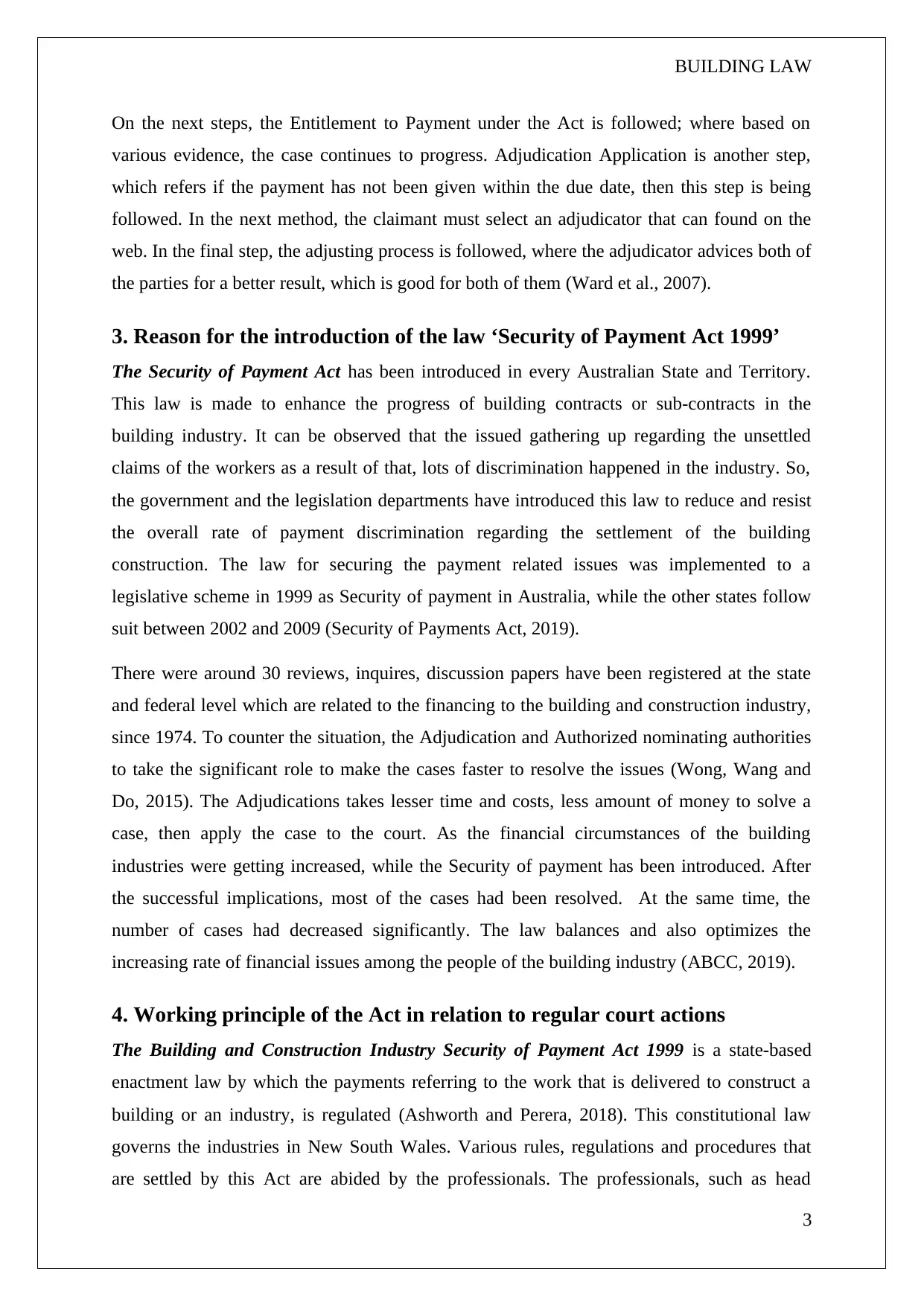
BUILDING LAW
On the next steps, the Entitlement to Payment under the Act is followed; where based on
various evidence, the case continues to progress. Adjudication Application is another step,
which refers if the payment has not been given within the due date, then this step is being
followed. In the next method, the claimant must select an adjudicator that can found on the
web. In the final step, the adjusting process is followed, where the adjudicator advices both of
the parties for a better result, which is good for both of them (Ward et al., 2007).
3. Reason for the introduction of the law ‘Security of Payment Act 1999’
The Security of Payment Act has been introduced in every Australian State and Territory.
This law is made to enhance the progress of building contracts or sub-contracts in the
building industry. It can be observed that the issued gathering up regarding the unsettled
claims of the workers as a result of that, lots of discrimination happened in the industry. So,
the government and the legislation departments have introduced this law to reduce and resist
the overall rate of payment discrimination regarding the settlement of the building
construction. The law for securing the payment related issues was implemented to a
legislative scheme in 1999 as Security of payment in Australia, while the other states follow
suit between 2002 and 2009 (Security of Payments Act, 2019).
There were around 30 reviews, inquires, discussion papers have been registered at the state
and federal level which are related to the financing to the building and construction industry,
since 1974. To counter the situation, the Adjudication and Authorized nominating authorities
to take the significant role to make the cases faster to resolve the issues (Wong, Wang and
Do, 2015). The Adjudications takes lesser time and costs, less amount of money to solve a
case, then apply the case to the court. As the financial circumstances of the building
industries were getting increased, while the Security of payment has been introduced. After
the successful implications, most of the cases had been resolved. At the same time, the
number of cases had decreased significantly. The law balances and also optimizes the
increasing rate of financial issues among the people of the building industry (ABCC, 2019).
4. Working principle of the Act in relation to regular court actions
The Building and Construction Industry Security of Payment Act 1999 is a state-based
enactment law by which the payments referring to the work that is delivered to construct a
building or an industry, is regulated (Ashworth and Perera, 2018). This constitutional law
governs the industries in New South Wales. Various rules, regulations and procedures that
are settled by this Act are abided by the professionals. The professionals, such as head
3
On the next steps, the Entitlement to Payment under the Act is followed; where based on
various evidence, the case continues to progress. Adjudication Application is another step,
which refers if the payment has not been given within the due date, then this step is being
followed. In the next method, the claimant must select an adjudicator that can found on the
web. In the final step, the adjusting process is followed, where the adjudicator advices both of
the parties for a better result, which is good for both of them (Ward et al., 2007).
3. Reason for the introduction of the law ‘Security of Payment Act 1999’
The Security of Payment Act has been introduced in every Australian State and Territory.
This law is made to enhance the progress of building contracts or sub-contracts in the
building industry. It can be observed that the issued gathering up regarding the unsettled
claims of the workers as a result of that, lots of discrimination happened in the industry. So,
the government and the legislation departments have introduced this law to reduce and resist
the overall rate of payment discrimination regarding the settlement of the building
construction. The law for securing the payment related issues was implemented to a
legislative scheme in 1999 as Security of payment in Australia, while the other states follow
suit between 2002 and 2009 (Security of Payments Act, 2019).
There were around 30 reviews, inquires, discussion papers have been registered at the state
and federal level which are related to the financing to the building and construction industry,
since 1974. To counter the situation, the Adjudication and Authorized nominating authorities
to take the significant role to make the cases faster to resolve the issues (Wong, Wang and
Do, 2015). The Adjudications takes lesser time and costs, less amount of money to solve a
case, then apply the case to the court. As the financial circumstances of the building
industries were getting increased, while the Security of payment has been introduced. After
the successful implications, most of the cases had been resolved. At the same time, the
number of cases had decreased significantly. The law balances and also optimizes the
increasing rate of financial issues among the people of the building industry (ABCC, 2019).
4. Working principle of the Act in relation to regular court actions
The Building and Construction Industry Security of Payment Act 1999 is a state-based
enactment law by which the payments referring to the work that is delivered to construct a
building or an industry, is regulated (Ashworth and Perera, 2018). This constitutional law
governs the industries in New South Wales. Various rules, regulations and procedures that
are settled by this Act are abided by the professionals. The professionals, such as head
3
Paraphrase This Document
Need a fresh take? Get an instant paraphrase of this document with our AI Paraphraser
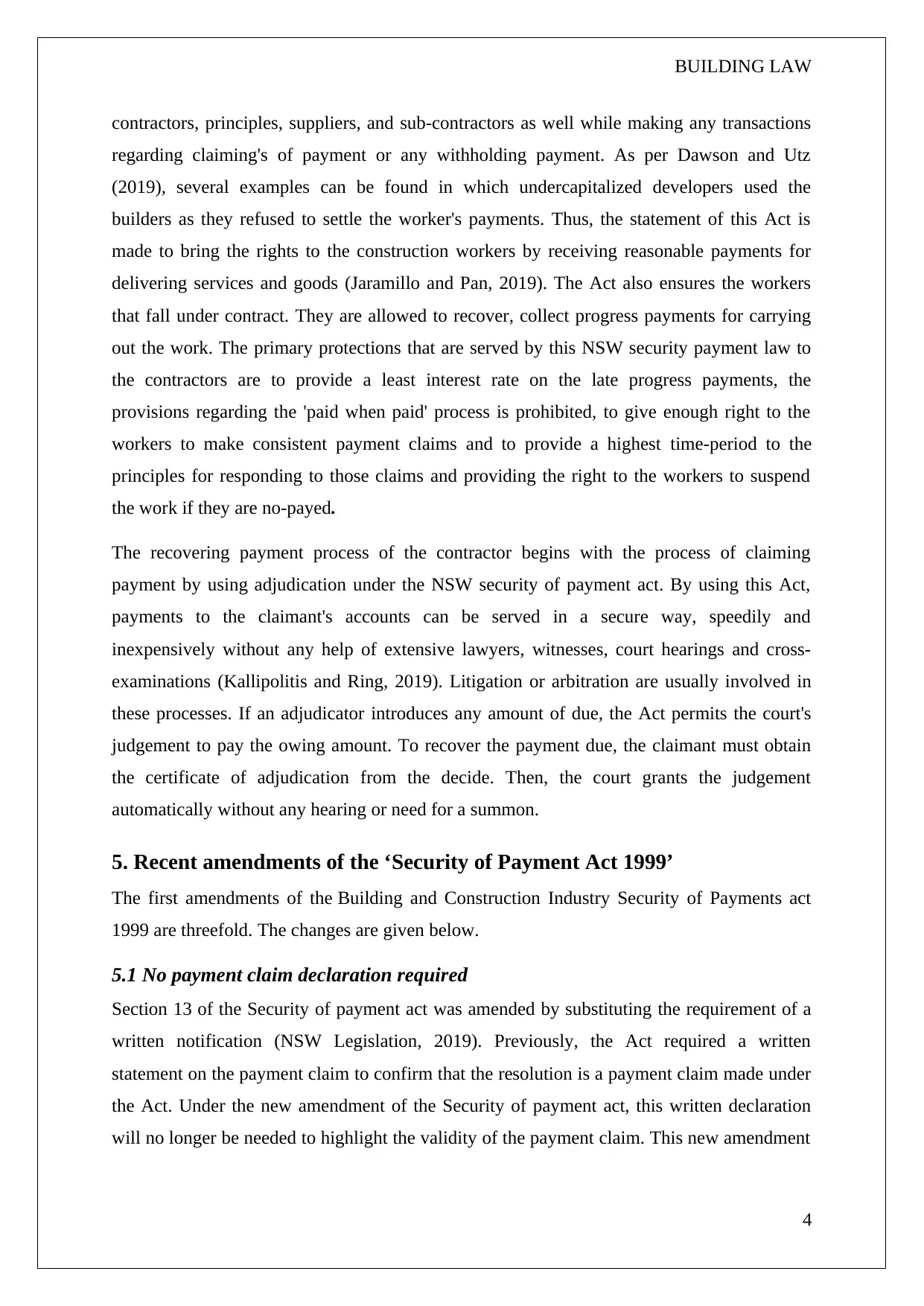
BUILDING LAW
contractors, principles, suppliers, and sub-contractors as well while making any transactions
regarding claiming's of payment or any withholding payment. As per Dawson and Utz
(2019), several examples can be found in which undercapitalized developers used the
builders as they refused to settle the worker's payments. Thus, the statement of this Act is
made to bring the rights to the construction workers by receiving reasonable payments for
delivering services and goods (Jaramillo and Pan, 2019). The Act also ensures the workers
that fall under contract. They are allowed to recover, collect progress payments for carrying
out the work. The primary protections that are served by this NSW security payment law to
the contractors are to provide a least interest rate on the late progress payments, the
provisions regarding the 'paid when paid' process is prohibited, to give enough right to the
workers to make consistent payment claims and to provide a highest time-period to the
principles for responding to those claims and providing the right to the workers to suspend
the work if they are no-payed.
The recovering payment process of the contractor begins with the process of claiming
payment by using adjudication under the NSW security of payment act. By using this Act,
payments to the claimant's accounts can be served in a secure way, speedily and
inexpensively without any help of extensive lawyers, witnesses, court hearings and cross-
examinations (Kallipolitis and Ring, 2019). Litigation or arbitration are usually involved in
these processes. If an adjudicator introduces any amount of due, the Act permits the court's
judgement to pay the owing amount. To recover the payment due, the claimant must obtain
the certificate of adjudication from the decide. Then, the court grants the judgement
automatically without any hearing or need for a summon.
5. Recent amendments of the ‘Security of Payment Act 1999’
The first amendments of the Building and Construction Industry Security of Payments act
1999 are threefold. The changes are given below.
5.1 No payment claim declaration required
Section 13 of the Security of payment act was amended by substituting the requirement of a
written notification (NSW Legislation, 2019). Previously, the Act required a written
statement on the payment claim to confirm that the resolution is a payment claim made under
the Act. Under the new amendment of the Security of payment act, this written declaration
will no longer be needed to highlight the validity of the payment claim. This new amendment
4
contractors, principles, suppliers, and sub-contractors as well while making any transactions
regarding claiming's of payment or any withholding payment. As per Dawson and Utz
(2019), several examples can be found in which undercapitalized developers used the
builders as they refused to settle the worker's payments. Thus, the statement of this Act is
made to bring the rights to the construction workers by receiving reasonable payments for
delivering services and goods (Jaramillo and Pan, 2019). The Act also ensures the workers
that fall under contract. They are allowed to recover, collect progress payments for carrying
out the work. The primary protections that are served by this NSW security payment law to
the contractors are to provide a least interest rate on the late progress payments, the
provisions regarding the 'paid when paid' process is prohibited, to give enough right to the
workers to make consistent payment claims and to provide a highest time-period to the
principles for responding to those claims and providing the right to the workers to suspend
the work if they are no-payed.
The recovering payment process of the contractor begins with the process of claiming
payment by using adjudication under the NSW security of payment act. By using this Act,
payments to the claimant's accounts can be served in a secure way, speedily and
inexpensively without any help of extensive lawyers, witnesses, court hearings and cross-
examinations (Kallipolitis and Ring, 2019). Litigation or arbitration are usually involved in
these processes. If an adjudicator introduces any amount of due, the Act permits the court's
judgement to pay the owing amount. To recover the payment due, the claimant must obtain
the certificate of adjudication from the decide. Then, the court grants the judgement
automatically without any hearing or need for a summon.
5. Recent amendments of the ‘Security of Payment Act 1999’
The first amendments of the Building and Construction Industry Security of Payments act
1999 are threefold. The changes are given below.
5.1 No payment claim declaration required
Section 13 of the Security of payment act was amended by substituting the requirement of a
written notification (NSW Legislation, 2019). Previously, the Act required a written
statement on the payment claim to confirm that the resolution is a payment claim made under
the Act. Under the new amendment of the Security of payment act, this written declaration
will no longer be needed to highlight the validity of the payment claim. This new amendment
4
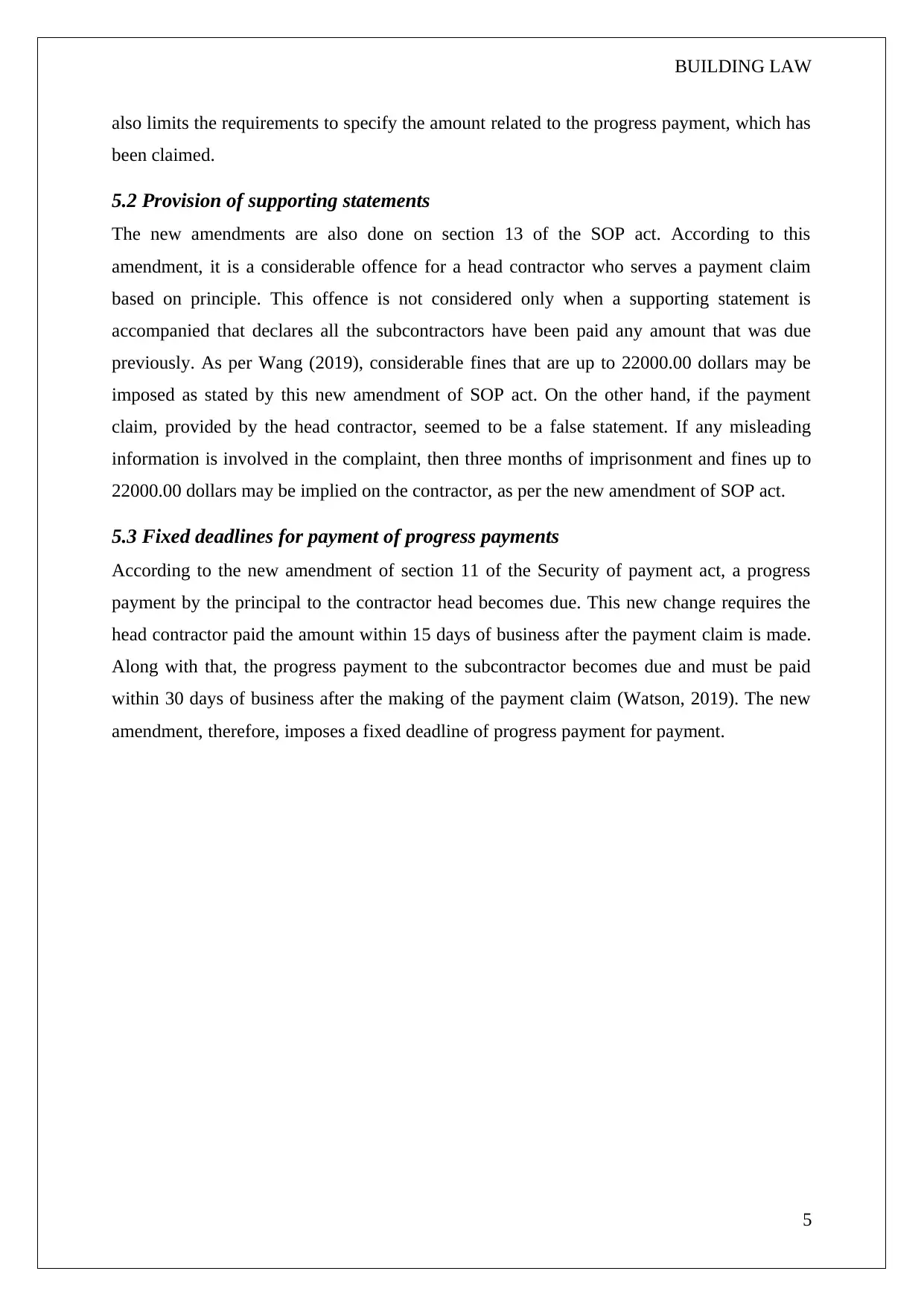
BUILDING LAW
also limits the requirements to specify the amount related to the progress payment, which has
been claimed.
5.2 Provision of supporting statements
The new amendments are also done on section 13 of the SOP act. According to this
amendment, it is a considerable offence for a head contractor who serves a payment claim
based on principle. This offence is not considered only when a supporting statement is
accompanied that declares all the subcontractors have been paid any amount that was due
previously. As per Wang (2019), considerable fines that are up to 22000.00 dollars may be
imposed as stated by this new amendment of SOP act. On the other hand, if the payment
claim, provided by the head contractor, seemed to be a false statement. If any misleading
information is involved in the complaint, then three months of imprisonment and fines up to
22000.00 dollars may be implied on the contractor, as per the new amendment of SOP act.
5.3 Fixed deadlines for payment of progress payments
According to the new amendment of section 11 of the Security of payment act, a progress
payment by the principal to the contractor head becomes due. This new change requires the
head contractor paid the amount within 15 days of business after the payment claim is made.
Along with that, the progress payment to the subcontractor becomes due and must be paid
within 30 days of business after the making of the payment claim (Watson, 2019). The new
amendment, therefore, imposes a fixed deadline of progress payment for payment.
5
also limits the requirements to specify the amount related to the progress payment, which has
been claimed.
5.2 Provision of supporting statements
The new amendments are also done on section 13 of the SOP act. According to this
amendment, it is a considerable offence for a head contractor who serves a payment claim
based on principle. This offence is not considered only when a supporting statement is
accompanied that declares all the subcontractors have been paid any amount that was due
previously. As per Wang (2019), considerable fines that are up to 22000.00 dollars may be
imposed as stated by this new amendment of SOP act. On the other hand, if the payment
claim, provided by the head contractor, seemed to be a false statement. If any misleading
information is involved in the complaint, then three months of imprisonment and fines up to
22000.00 dollars may be implied on the contractor, as per the new amendment of SOP act.
5.3 Fixed deadlines for payment of progress payments
According to the new amendment of section 11 of the Security of payment act, a progress
payment by the principal to the contractor head becomes due. This new change requires the
head contractor paid the amount within 15 days of business after the payment claim is made.
Along with that, the progress payment to the subcontractor becomes due and must be paid
within 30 days of business after the making of the payment claim (Watson, 2019). The new
amendment, therefore, imposes a fixed deadline of progress payment for payment.
5
⊘ This is a preview!⊘
Do you want full access?
Subscribe today to unlock all pages.

Trusted by 1+ million students worldwide
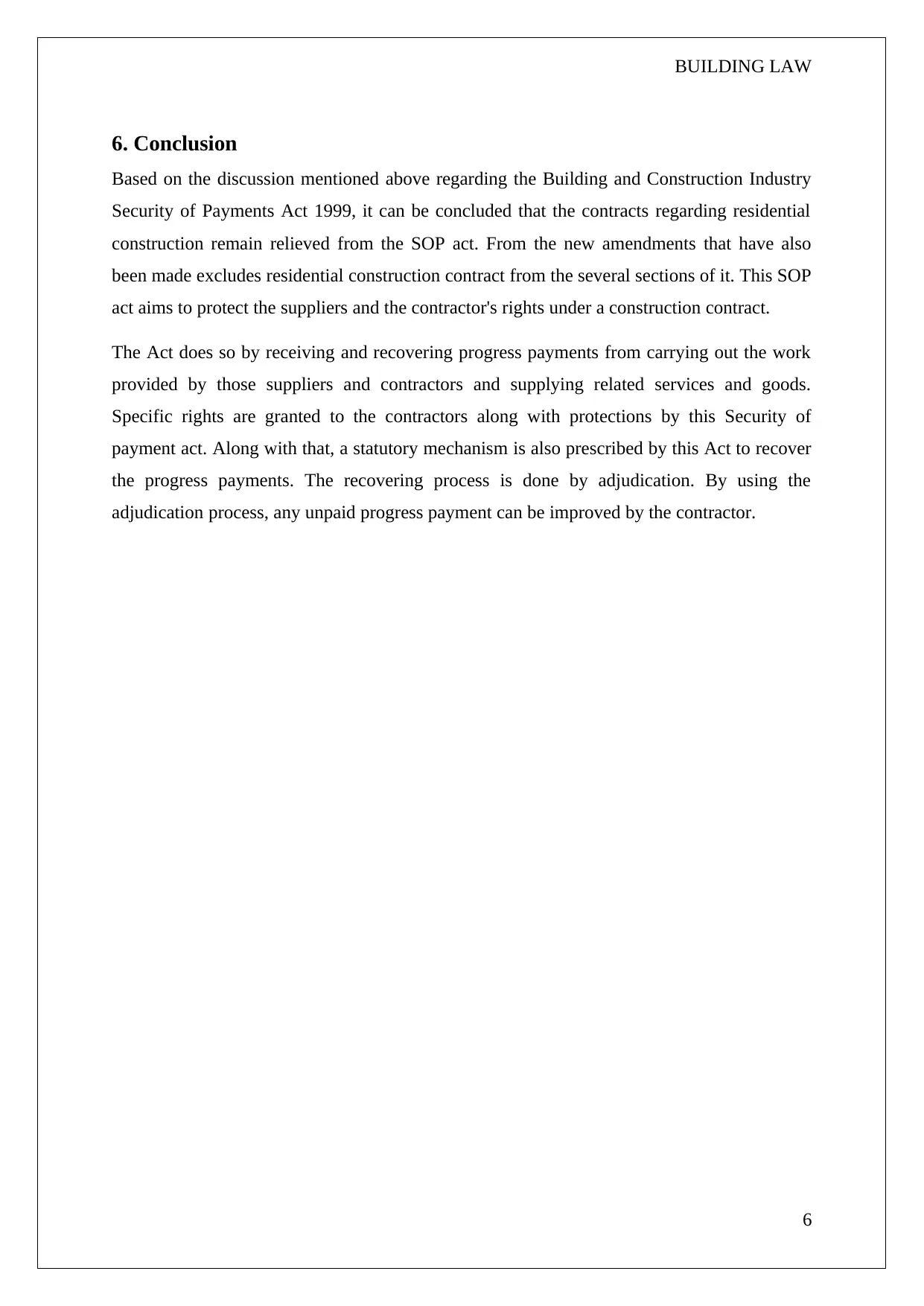
BUILDING LAW
6. Conclusion
Based on the discussion mentioned above regarding the Building and Construction Industry
Security of Payments Act 1999, it can be concluded that the contracts regarding residential
construction remain relieved from the SOP act. From the new amendments that have also
been made excludes residential construction contract from the several sections of it. This SOP
act aims to protect the suppliers and the contractor's rights under a construction contract.
The Act does so by receiving and recovering progress payments from carrying out the work
provided by those suppliers and contractors and supplying related services and goods.
Specific rights are granted to the contractors along with protections by this Security of
payment act. Along with that, a statutory mechanism is also prescribed by this Act to recover
the progress payments. The recovering process is done by adjudication. By using the
adjudication process, any unpaid progress payment can be improved by the contractor.
6
6. Conclusion
Based on the discussion mentioned above regarding the Building and Construction Industry
Security of Payments Act 1999, it can be concluded that the contracts regarding residential
construction remain relieved from the SOP act. From the new amendments that have also
been made excludes residential construction contract from the several sections of it. This SOP
act aims to protect the suppliers and the contractor's rights under a construction contract.
The Act does so by receiving and recovering progress payments from carrying out the work
provided by those suppliers and contractors and supplying related services and goods.
Specific rights are granted to the contractors along with protections by this Security of
payment act. Along with that, a statutory mechanism is also prescribed by this Act to recover
the progress payments. The recovering process is done by adjudication. By using the
adjudication process, any unpaid progress payment can be improved by the contractor.
6
Paraphrase This Document
Need a fresh take? Get an instant paraphrase of this document with our AI Paraphraser
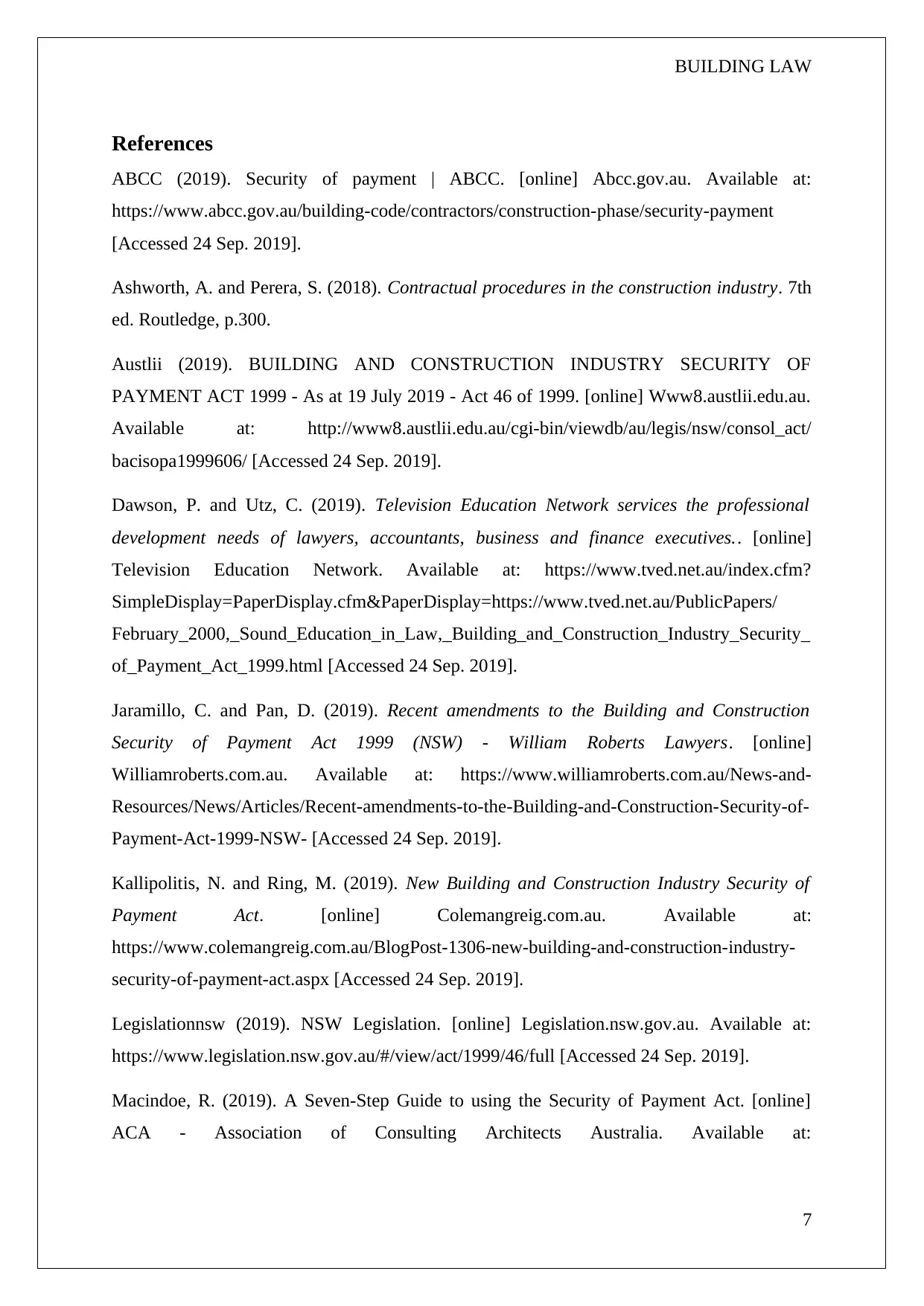
BUILDING LAW
References
ABCC (2019). Security of payment | ABCC. [online] Abcc.gov.au. Available at:
https://www.abcc.gov.au/building-code/contractors/construction-phase/security-payment
[Accessed 24 Sep. 2019].
Ashworth, A. and Perera, S. (2018). Contractual procedures in the construction industry. 7th
ed. Routledge, p.300.
Austlii (2019). BUILDING AND CONSTRUCTION INDUSTRY SECURITY OF
PAYMENT ACT 1999 - As at 19 July 2019 - Act 46 of 1999. [online] Www8.austlii.edu.au.
Available at: http://www8.austlii.edu.au/cgi-bin/viewdb/au/legis/nsw/consol_act/
bacisopa1999606/ [Accessed 24 Sep. 2019].
Dawson, P. and Utz, C. (2019). Television Education Network services the professional
development needs of lawyers, accountants, business and finance executives.. [online]
Television Education Network. Available at: https://www.tved.net.au/index.cfm?
SimpleDisplay=PaperDisplay.cfm&PaperDisplay=https://www.tved.net.au/PublicPapers/
February_2000,_Sound_Education_in_Law,_Building_and_Construction_Industry_Security_
of_Payment_Act_1999.html [Accessed 24 Sep. 2019].
Jaramillo, C. and Pan, D. (2019). Recent amendments to the Building and Construction
Security of Payment Act 1999 (NSW) - William Roberts Lawyers. [online]
Williamroberts.com.au. Available at: https://www.williamroberts.com.au/News-and-
Resources/News/Articles/Recent-amendments-to-the-Building-and-Construction-Security-of-
Payment-Act-1999-NSW- [Accessed 24 Sep. 2019].
Kallipolitis, N. and Ring, M. (2019). New Building and Construction Industry Security of
Payment Act. [online] Colemangreig.com.au. Available at:
https://www.colemangreig.com.au/BlogPost-1306-new-building-and-construction-industry-
security-of-payment-act.aspx [Accessed 24 Sep. 2019].
Legislationnsw (2019). NSW Legislation. [online] Legislation.nsw.gov.au. Available at:
https://www.legislation.nsw.gov.au/#/view/act/1999/46/full [Accessed 24 Sep. 2019].
Macindoe, R. (2019). A Seven-Step Guide to using the Security of Payment Act. [online]
ACA - Association of Consulting Architects Australia. Available at:
7
References
ABCC (2019). Security of payment | ABCC. [online] Abcc.gov.au. Available at:
https://www.abcc.gov.au/building-code/contractors/construction-phase/security-payment
[Accessed 24 Sep. 2019].
Ashworth, A. and Perera, S. (2018). Contractual procedures in the construction industry. 7th
ed. Routledge, p.300.
Austlii (2019). BUILDING AND CONSTRUCTION INDUSTRY SECURITY OF
PAYMENT ACT 1999 - As at 19 July 2019 - Act 46 of 1999. [online] Www8.austlii.edu.au.
Available at: http://www8.austlii.edu.au/cgi-bin/viewdb/au/legis/nsw/consol_act/
bacisopa1999606/ [Accessed 24 Sep. 2019].
Dawson, P. and Utz, C. (2019). Television Education Network services the professional
development needs of lawyers, accountants, business and finance executives.. [online]
Television Education Network. Available at: https://www.tved.net.au/index.cfm?
SimpleDisplay=PaperDisplay.cfm&PaperDisplay=https://www.tved.net.au/PublicPapers/
February_2000,_Sound_Education_in_Law,_Building_and_Construction_Industry_Security_
of_Payment_Act_1999.html [Accessed 24 Sep. 2019].
Jaramillo, C. and Pan, D. (2019). Recent amendments to the Building and Construction
Security of Payment Act 1999 (NSW) - William Roberts Lawyers. [online]
Williamroberts.com.au. Available at: https://www.williamroberts.com.au/News-and-
Resources/News/Articles/Recent-amendments-to-the-Building-and-Construction-Security-of-
Payment-Act-1999-NSW- [Accessed 24 Sep. 2019].
Kallipolitis, N. and Ring, M. (2019). New Building and Construction Industry Security of
Payment Act. [online] Colemangreig.com.au. Available at:
https://www.colemangreig.com.au/BlogPost-1306-new-building-and-construction-industry-
security-of-payment-act.aspx [Accessed 24 Sep. 2019].
Legislationnsw (2019). NSW Legislation. [online] Legislation.nsw.gov.au. Available at:
https://www.legislation.nsw.gov.au/#/view/act/1999/46/full [Accessed 24 Sep. 2019].
Macindoe, R. (2019). A Seven-Step Guide to using the Security of Payment Act. [online]
ACA - Association of Consulting Architects Australia. Available at:
7
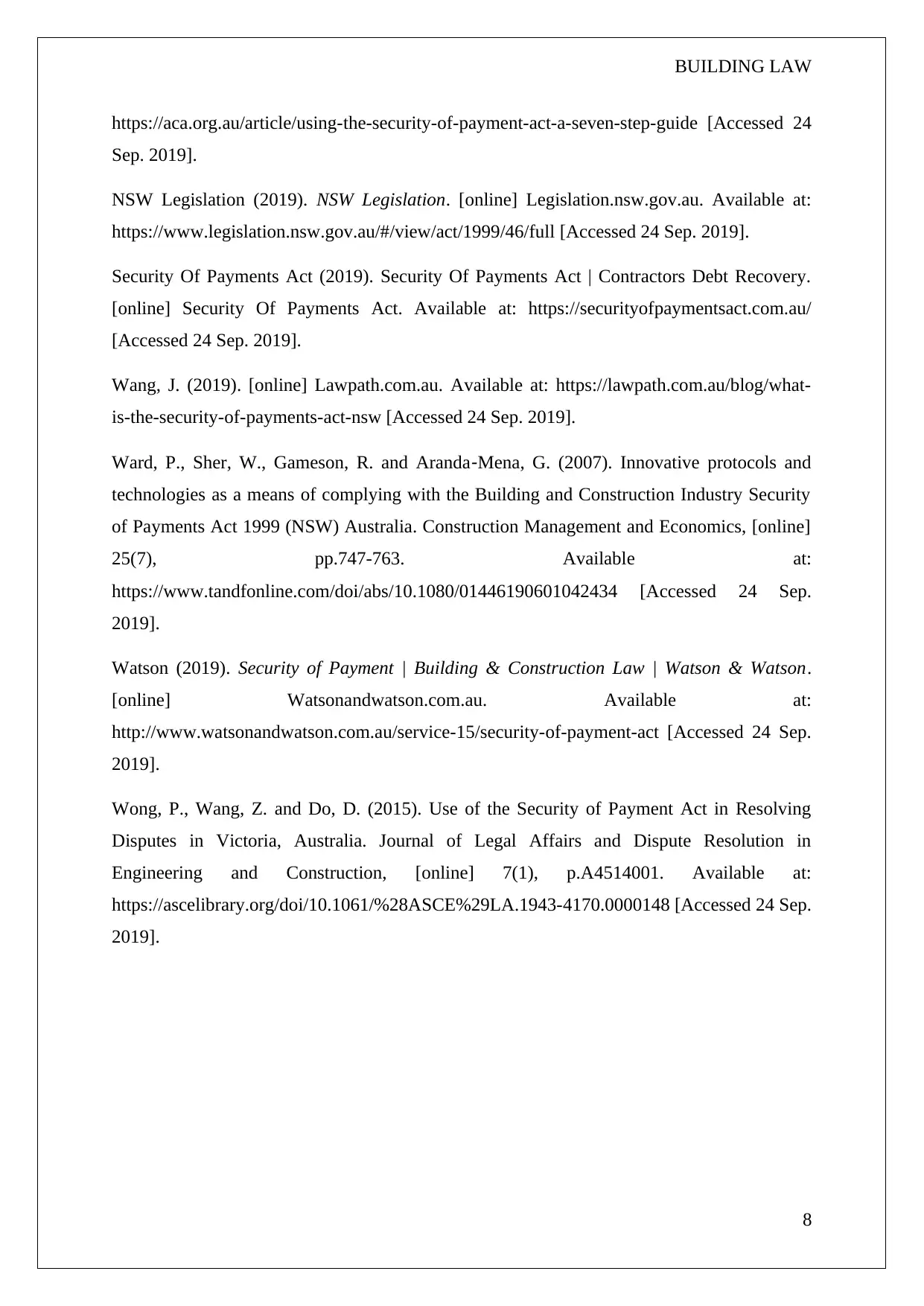
BUILDING LAW
https://aca.org.au/article/using-the-security-of-payment-act-a-seven-step-guide [Accessed 24
Sep. 2019].
NSW Legislation (2019). NSW Legislation. [online] Legislation.nsw.gov.au. Available at:
https://www.legislation.nsw.gov.au/#/view/act/1999/46/full [Accessed 24 Sep. 2019].
Security Of Payments Act (2019). Security Of Payments Act | Contractors Debt Recovery.
[online] Security Of Payments Act. Available at: https://securityofpaymentsact.com.au/
[Accessed 24 Sep. 2019].
Wang, J. (2019). [online] Lawpath.com.au. Available at: https://lawpath.com.au/blog/what-
is-the-security-of-payments-act-nsw [Accessed 24 Sep. 2019].
Ward, P., Sher, W., Gameson, R. and Aranda‐Mena, G. (2007). Innovative protocols and
technologies as a means of complying with the Building and Construction Industry Security
of Payments Act 1999 (NSW) Australia. Construction Management and Economics, [online]
25(7), pp.747-763. Available at:
https://www.tandfonline.com/doi/abs/10.1080/01446190601042434 [Accessed 24 Sep.
2019].
Watson (2019). Security of Payment | Building & Construction Law | Watson & Watson.
[online] Watsonandwatson.com.au. Available at:
http://www.watsonandwatson.com.au/service-15/security-of-payment-act [Accessed 24 Sep.
2019].
Wong, P., Wang, Z. and Do, D. (2015). Use of the Security of Payment Act in Resolving
Disputes in Victoria, Australia. Journal of Legal Affairs and Dispute Resolution in
Engineering and Construction, [online] 7(1), p.A4514001. Available at:
https://ascelibrary.org/doi/10.1061/%28ASCE%29LA.1943-4170.0000148 [Accessed 24 Sep.
2019].
8
https://aca.org.au/article/using-the-security-of-payment-act-a-seven-step-guide [Accessed 24
Sep. 2019].
NSW Legislation (2019). NSW Legislation. [online] Legislation.nsw.gov.au. Available at:
https://www.legislation.nsw.gov.au/#/view/act/1999/46/full [Accessed 24 Sep. 2019].
Security Of Payments Act (2019). Security Of Payments Act | Contractors Debt Recovery.
[online] Security Of Payments Act. Available at: https://securityofpaymentsact.com.au/
[Accessed 24 Sep. 2019].
Wang, J. (2019). [online] Lawpath.com.au. Available at: https://lawpath.com.au/blog/what-
is-the-security-of-payments-act-nsw [Accessed 24 Sep. 2019].
Ward, P., Sher, W., Gameson, R. and Aranda‐Mena, G. (2007). Innovative protocols and
technologies as a means of complying with the Building and Construction Industry Security
of Payments Act 1999 (NSW) Australia. Construction Management and Economics, [online]
25(7), pp.747-763. Available at:
https://www.tandfonline.com/doi/abs/10.1080/01446190601042434 [Accessed 24 Sep.
2019].
Watson (2019). Security of Payment | Building & Construction Law | Watson & Watson.
[online] Watsonandwatson.com.au. Available at:
http://www.watsonandwatson.com.au/service-15/security-of-payment-act [Accessed 24 Sep.
2019].
Wong, P., Wang, Z. and Do, D. (2015). Use of the Security of Payment Act in Resolving
Disputes in Victoria, Australia. Journal of Legal Affairs and Dispute Resolution in
Engineering and Construction, [online] 7(1), p.A4514001. Available at:
https://ascelibrary.org/doi/10.1061/%28ASCE%29LA.1943-4170.0000148 [Accessed 24 Sep.
2019].
8
⊘ This is a preview!⊘
Do you want full access?
Subscribe today to unlock all pages.

Trusted by 1+ million students worldwide
1 out of 9
Related Documents
Your All-in-One AI-Powered Toolkit for Academic Success.
+13062052269
info@desklib.com
Available 24*7 on WhatsApp / Email
![[object Object]](/_next/static/media/star-bottom.7253800d.svg)
Unlock your academic potential
Copyright © 2020–2025 A2Z Services. All Rights Reserved. Developed and managed by ZUCOL.





